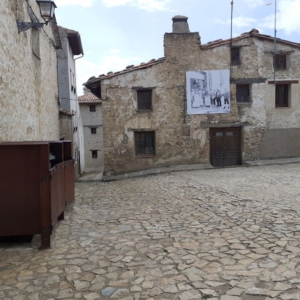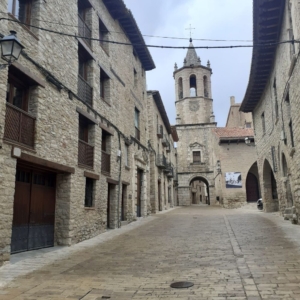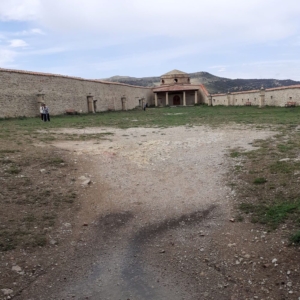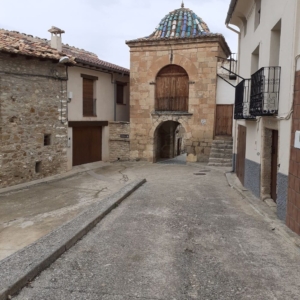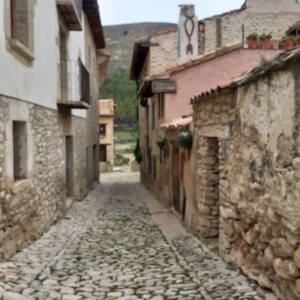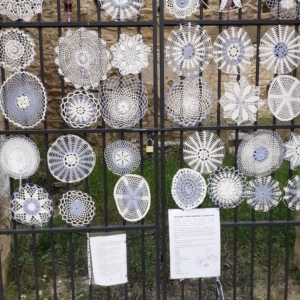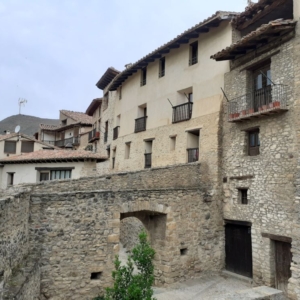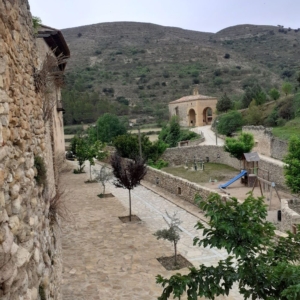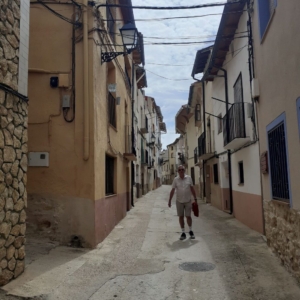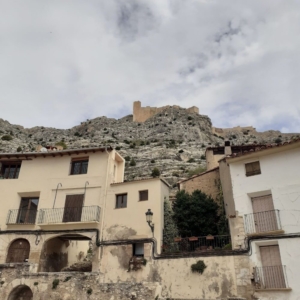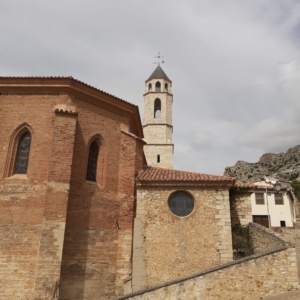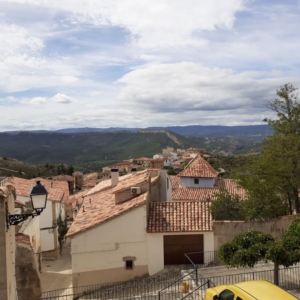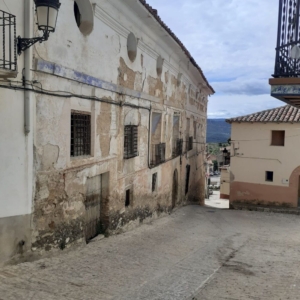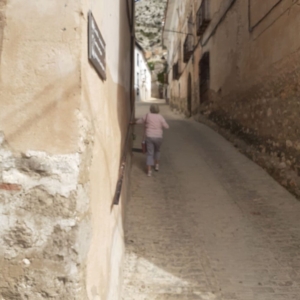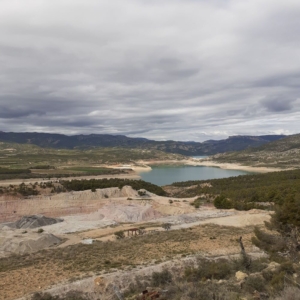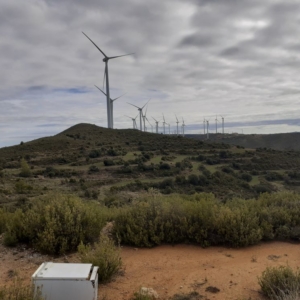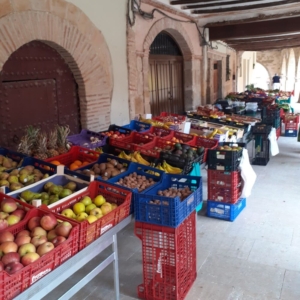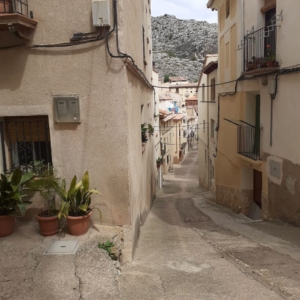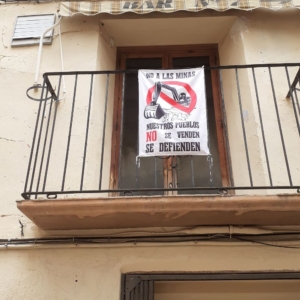This records our trip to the Maestrazgo region, which is an inland area, just northwest of Valencia from the 6th to 9th June 2023.
The round trip was a total of 888 kms.
Tuesday 6th June
Left home at 9.00 and took Angel to Val & Geoff’s for his holiday! Left their house at 10.00 and drove for 3 hrs.40min and stopped twice for coffees and beers. Arrived at our hotel HOTEL & SPA BALFAGON in Cantavieja at 3.00.Very nice 4 star hotel booked through booking.com. Had a rest in our room and then walked around the town. This town has always been considered to be the capital town of the Alta Maestrazgo region. The town is surrounded by mountains and valleys of outstanding beauty. This town declared as being of historical and artistic interest in 1981. The town is remarkable for the structure and position of its urban layout, perched on top of a mountain and surrounded by gorges. In the area are 125 “Masias” or farms that are still inhabited, some of which do not have electricity. It is a position worthy of its historical role. Legend has it that the castle was built by Hannibal who passed through Spain on his way to Italy There is a beautiful porticoed square set before the Church of Assumption, from the 17th and 18th centuries, the Town Hall and the Casa del Bayle. Other monuments of interest are the San Miguel hermitage, the ruins of the castle and the walls, Casa Zurita, Casa Peralta and the coat of arms on the remaining facades of other houses of the nobility are still intact.
We were disappointed to find that many of the restaurants only stayed open for lunch and not in the evening – In fact many were closed on Tuesdays! As we were quite tired just had evening drink and snack in the cafeteria of the hotel. The staff were all very friendly but we did not hear any English the whole 4 days! This was good for practising our Spanish.
The current population is 707 while in 1857 it was 1,943 which indicates a huge move out of Maestrazgo in the last 160 years. From our tour in the region this trend is unlikely to be reversed. Many of the little towns had one bar and sometimes a shop which wasn’t open every day.
Wednesday 7th June
Left hotel at 9.00 to travel to Mirambel which was 15km away. Its walled perimeter has been perfectly preserved and can only be entered via one of its five gates. Once inside we found a peaceful village where it seems that time has stood still. The 17th century Church of Santa Margrita, the remains of the castle, the convent and the Portal de la Monjas founded by Felipe 11, the Town Hall and other houses such as Casa Zurita, Casa Aliaga, Casa Castellot, Casa Pastor and Casa Costeras are of note. Mirambel is a surprise at every turn. It has been used as a film location and scenes from the films “Tierra y Liberdad” and many others have been shot here. On our visit we only saw two people until we went into a bar for a coffee to find it full of working men at least 15/20 drinking coffee and brandies. Population now 111 (1857 it was 960).
We have some of our photos below but this video beats them
We then drove on to La Cuba a small village on the provincial border with Castellon. We walked round the village streets and saw the Church of San Miguel and the Town Hall from the 17th century. Again only saw one person. Population is 42 (1857 – it was 489) We missed seeing the centre for the wicker industry, in which the entire village worked in bygone days.
Then on to Tronchon which was controlled as many other villages in the Maestrazgo in 1212 by the religious Order of the Temparios whose headquarters was based in Cantavieja. Tronchon like all villages in the Maestrazgos region suffered during the Carlist wars of succession. Today the village maintains a high level of notoriety in the gastronomic world by the artisan method of cheese manufacturing. Truchon cheese can be traced back nearly five hundred years and even received a mention in Cervantes, Don Quixote de la Mancha (first published in 1605) All this lost on Tony who is not a cheese lover! When Val & Geoff visited Tronchon they had a great meal at Matildas (see picture). Again empty streets but on leaving saw many goats and sheep (see picture) Population now 61 (1857 – 1,087)
From Tronchon took small road to Villaluego which we missed seeing as the road was difficult with many falling rocks and fir trees. Beautiful scenery and went through Canada de Benatanduz This village is set above the deepest gorges, stretching across the hillocks barely forms streets. At the core of the hamlet. The 18th century Church of the Assumption, the Aragonese style Town Hall and the Paupers Hospital, both from the 16th century. Population 42 (1857 – 576).
Carried on driving and did not stop until we got back to the hotel in Cantavieja. By this time already showing 408 km on the clock, and it was raining. Decided to have a small meal again in the cafeteria.
Thursday 8th June
A cloudy day with rain expected so set off again at 9 o’clock. Driving through Mirambel, Olocalu del Rey and Bordon. After exactly one hour and 43 km we had a total of 3 cars passing us in the other direction which shows how quiet this region is.
Arrived in Castellote a 49 km journey from our hotel and stopped for coffee and croissant in a square before the tunnel. We parked the car and then walked round the old town. Castelotte Old Town has been declared a site of historic-artistic interest. The highlights are The 15th Century gothic church of San Miguel, the 17th century hermitage of La Virgen del Agua, the arches of the city walls, the Town Hall and various building dating from the 16th to 19th century. See various pictures. Population currently 677 compared to 2,511 in 1857.
We then left through the tunnel to Molinos 16km away We admired the 12th century medieval tower and the 16th century Town hall. The church of Nuestra Senora de las Nieves – a piece of 15th century gothic architecture, the San Nicolas gorge . We missed visiting the Crystal Caves a genuine subterranean marvel but here is a super video of them (in Spanish but that doesn’t matter). We took some pictures including the fruit market. Population now 227 compared to 1,363 in 1857.
Then driving on to Las Cuevas de Canart again declared an area of historic-artistic interest with many highlights The 1770 Church of San Pedro Apostel, The 1648 San Blas hermitage and many other interesting buildings and noble houses. Visited the Tourist Office and was given an interesting map of the Maestrazgo – Territoria de las Guerras Carlistas.
We then headed for Ladrunan and La Algecira but the road was so suspect we headed back to Don Torres de Mercador where we visited a bar where there was only a machine and for 1 euro we got a can of drink. But locals outside the bar drinking from cans could not help us on the road so headed back on same road to Castelotte and back to the hotel in Cantaviejo for our evening V & T and G & T
Later in the evening had a lovely meal in the Hotel restaurant


Friday 9th June
Paid the hotel bill €584 which we felt was very reasonable for 3 nights and various drinks and food and two special books (one for Val & Geoff) all about the Maestrazgo
Left hotel to head straight back home via Fortanete/ Villarroya de los Pinares and Allepuz all lovely villages to drive through and spectacular scenery such as this –
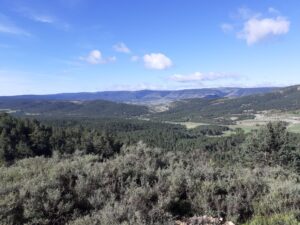
but after all the driving did not feel like having any more stops except for refreshments. Arrived back at Val & Geoff’s to pick up Angel at 2 o’clock

